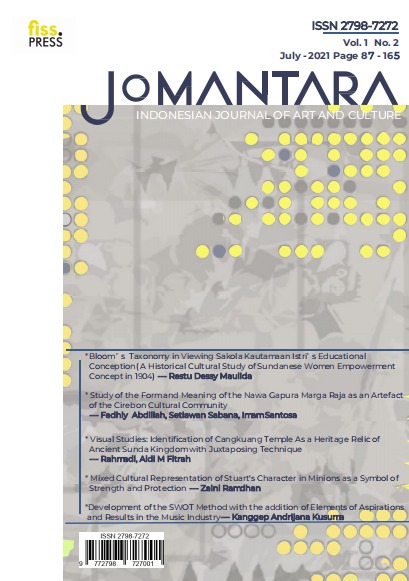Study of the Form and Meaning of the Nawa Gapura Marga Raja as an Artefact of the Cirebon Cultural Community
Form and Meaning Nawa Gapura Marga Raja
DOI:
https://doi.org/10.23969/jijac.v1i2.4371Keywords:
form, art criticism, visual narrative, meaning, nawa gapura marga rajaAbstract
A work of traditional culture by the geniuses of Cirebon's past, named Nawa Gapura Marga Raja, is one of the historical buildings that are still sacred. There are 9 doors or gates, each of which is gathered in one area of the building. The form and meaning of the number of gates for the author is a very interesting phenomenon to study, its relation to cultural expressions that allow so many symbolic values to be interpreted. This study of form and meaning aims to analyze and gain knowledge related to the form and visual meaning of the gates in this building. To find out the meaning of the physical form of Nawa Gapura Marga Raja, this study uses an art criticism approach from Edmund Burke Feldman with the visual narration method of Gerard Genette. In the process, the research goes through the following stages; literature study, observation, and conducting interviews with related parties. From the results of the analysis, it is understood that the structure of the form and layout of the building is heavily influenced by the spatial concept of primordial culture mixed with a new culture, so that it represents a myth, also has meanings that are closely related to religious teachings, culture and leadership values.
Keywords: form, art criticism, visual narrative, meaning, nawa gapura marga raja
Downloads
References
Agustina, I., Djunaedi, A., Sudaryono, S., & Suryo, D. (2013). Gerak Ruang Kawasan Keraton Kasepuhan. Jurnal Perencanaan Wilayah Dan Kota, 13(1), 125197.
Atja. (1986). Tjarita Purwaka Caruban Nagari. Proyek Pengembangan Permuseuman Jawa Barat.
Ayatrohaedi. (2017). Sundakala, Cuplikan Sejarah Sunda Berdasarkan Naskah-Naskah Panitia Wangsakerta Crebon (1st ed.). PT. Dunia Pustaka Jaya.
Edi S Ekadjati. (2017). Polemik Naskah Pangeran WEangsakerta. PT. Dunia Pustaka Jaya.
Hendriyana, H. (2007). Makna dan Simbol Gerbang Sembilan Astana Sunan Gunung Jati Cirebon. ITB.
Humaedi, M. A. (2013). Budaya Hibrida Masyarakat Cirebon. Humaniora, 25(3), 281–295.
Mitleton-Kelly, E., Paraskevas, A., Day, C., & Paraskevas, P. A. (2018). Visual Methodologies. In Handbook of Research Methods in Complexity Science. https://doi.org/10.4337/9781785364426.00017
Murdihastomo, A., & Bauty, I. (2020). Konstruksi Sosial masyarakat Tehadap Keramik Asing di Bangunan Masjid Panjunan, Cirebon. PURBAWIDYA: Jurnal Penelitian Dan Pengembangan Arkeologi, 9(1), 63–78. https://doi.org/10.24164/pw.v9i1.334
Siti, K. (2011). Kearifan Lokal Pada Masyarakat Cirebon. Sosietas, 1(1). https://doi.org/10.17509/sosietas.v1i1.1112
Whitehead, A. N. (1927). Symbolism Its Meaning and Effect (T. Company Macmillan (ed.); First). THE SYNDICS OF THE CAMBRIDGE UNIVERSITY PRESS.
Yani, A. (2011). Pengaruh Islam Terhadap Makna Simbolik Budaya Keraton-Keraton Cirebon. Holistik, 12(01), 16. file:///C:/Users/ACER/Downloads/82-296-1-PB (2).pdf
Downloads
Published
Issue
Section
License
Copyright Notice

This work is licensed under a Creative Commons Attribution 4.0 International License.









